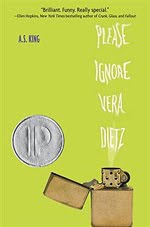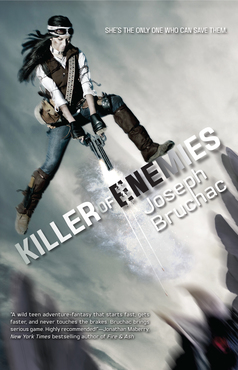 |
| Book cover from Andrew Smith |
Smith, A. (2014). Grasshopper jungle. New York, NY: Dutton Books.
*Grade level 10 and up
**2015 Michael L. Printz Honor for Excellence in Young Adult Literature
**2014 Boston Globe Horn-Book Award for Fiction
Austin Szerba is the historian of the end of the world. He's a Lutheran school boy from Ealing, Iowa who is in love with both his girlfriend Shann and his best friend Robby, even though he doesn't understand how this could be. Austin's hormones are out of control, even by the standards of a normal sixteen-year-old. One night, the world ends, but it takes several days before anyone realizes. Six-foot-tall praying mantises have begun to kill and breed in Ealing, and only Austin and Robby really know what is happening, and they feel partly responsible and want to stop the creatures from ending humanity. Austin records the events as they happen and after, tying them back to historical events and his own family's history. The story is sometimes scary, often crude, and always hilarious--a perfect book for teenagers who want to read a story that is honest and true to life, while also being crazy and sensational.
Partner Titles:
 |
| Book cover from Penguin Australia |
Vonnegut, K. (1963). Cat's cradle. New York, NY: Holt Rinehart and Winston.
Smith has often been compared to Vonnegut. Their writing styles are undoubtedly similar, so it's only natural to read a Vonnegut novel in conjunction with Grasshopper Jungle. The science fiction book Cat's Cradle is a fantastic partner title because it is also about the negligence of scientists in their work, resulting in the end of the world. There are also themes of truth throughout both novels. The narrators would make for an interesting contrast in their storytelling. Austin states, "I have no reason to lie" and Vonnegut's narrator Jonah states, "All of the true things I am about to tell you are shameless lies." They face the end of the world in different ways, but they both analyze their very serious situations with humor.
**2014 American Indian Youth Literature Award from the American Indian Library Association
This steampunk/science fiction novel is about Lozen, an Apache teenager who learns to protect herself and must save her family in a post-apocalyptic world. Lozen is unlike Austin and Robby in that she has supernatural powers, but like Austin's predilection for tying the present to the past, Lozen's powers are connected to ancient myths of her tribe. The themes of history and survival tie these stories together.
**2014 Andre Norton Award Nominee from the Science Fiction Writers of America
Glory has the ability to see into the future in this science fiction novel. What she sees is scary, but can she really do anything about it? Like Austin and Robby, maybe she can help save the world. She begins writing down the future just as Austin records history. They both ask themselves the question: What am I going to do?
 |
| Book cover from A.S. King |
King, A.S. (2010). Please ignore Vera Dietz. New York, NY: Alfred A. Knopf.
**2011 Michael L. Printz Honor
**2011 Edgar Allan Poe Award Nominee
Like Austin, Vera is also in love with her best friend, but Charlie never knew it. When he mysteriously dies, Vera doesn't know how much to tell. Both books are dramatic and funny at the same time and share the theme of confusing love. Austin and Vera are both observant of the world around them and sensitive without being mushy.
 |
| Book cover from Simon & Schuster |
Saenz, B.A. (2012). Aristotle and Dante discover the secrets of the universe. New York, NY: Simon & Schuster.
**2013 Pura Belpre Award
**2013 Stonewall Book Award
**2013 Michael L. Printz Honor
Ari is a loner who is angry most of the time. His brother is in prison and he doesn't feel close to his parents. He meets Dante (another Mexican-American boy with a Greek philosopher's name) one summer and they become best friends. Dante surprises Ari by telling him he is gay, and they continue to support one another no matter what, even as Ari works to discover who he really is. Shared themes of homosexuality and friendship connect this book to Grasshopper Jungle. Both sets of boys love each other unconditionally.
Teaching Ideas:
"A Good Iowa Name": Some of the names of people and places in the novel are remarked upon as having "a good Iowa name." Ask students to analyze these poetic names to see what kinds of sound devices they have in common. What makes these names more interesting than the ones that are not good Iowa names? After discussing, have students come up with some Iowan names of their own, for both people and businesses.
English 11.4 The student will read, comprehend, and analyze relationships among American literature, history, and culture. f) Explain how the sound of a poem (rhyme, rhythm, onomatopoeia, repetition, alliteration, assonance, and parallelism) supports the subject, mood, and theme (VDOE, 2010a, p. 2).
Genetic Engineering: In the novel, scientists have used genetic material from both humans and praying mantises as fertilizer, with negative consequences. After studying basic genetics, biology students could analyze the science in the novel to explain why it is indeed fiction. Which parts seem possible? Which parts are impossible? Why does science fiction require some of the science to seem likely?
BIO.5 The student will investigate and understand common mechanisms of inheritance and protein synthesis. Key concepts include i) use, limitations, and misuse of genetic information (VDOE, 2010c, p. 7).
The Cave of Altamira: Austin refers to the Altamira cave paintings, comparing them to the journals he uses to record history and show connections throughout history and all over the world. World History students can research the cave paintings and explain how their discovery has changed our perspective on history and early people.
WHI.2 The student will demonstrate knowledge of early development of humankind from the Paleolithic Era to the agricultural revolution by: d) explaining how archaeological discoveries are changing present-day knowledge of early people (VDOE, 2008, p. 1).
Relationship Advice: Ask students to brainstorm what is important to them in a relationship, both their role and the role of a boyfriend or girlfriend. Discuss and share ideas, then have them come up with some advice for Austin. Austin loves both Robby and Shann, which creates a lot of tension in the story. For an extra challenge, give advice to Robby and Shann as well.
10.2 The student will describe his or her own attitudes concerning expectations of self and interpersonal relationships (VDOE, 2011, p. 36).
"Dulce et Decorum Est": Robby's favorite poem is "Dulce et Decorum est" by Wilfred Owen, and Austin refers back to the poem several times throughout the book. Discuss the poem as a class. Students should pay attention to each allusion as it appears in the novel. They can pick their favorite instances and analyze why they think it is appropriate for that moment in the book. Also, why is this an appropriate poem to represent Robby?
12.6 The student will develop expository and informational, analyses, and persuasive/argumentative writings. c) Clarify and defend a position with precise and relevant evidence (VDOE, 2010b, p. 2).
References:
Virginia Department of Education. (2008). World history and geography to 1500 A.D. (C.E.). History and social science standards of learning for Virginia public schools. Retrieved from http://www.doe.virginia.gov/testing/sol/standards_docs/history_socialscience/next_version/stds_worldhistory_geography_to1500.pdf
Virginia Department of Education. (2010a). Grade eleven. English standards of learning for Virginia public schools. Retrieved from http://www.doe.virginia.gov/testing/sol/standards_docs/english/2010/stds_english11.pdf
Virginia Department of Education. (2010b). Grade twelve. English standards of learning for Virginia public schools. Retrieved from http://www.doe.virginia.gov/testing/sol/standards_docs/english/2010/stds_english12.pdf
Virginia Department of Education. (2010c). Science standards of learning for Virginia public schools. Retrieved from http://www.doe.virginia.gov/testing/sol/standards_docs/science/2010/courses/stds_biology.pdf
Virginia Department of Education. (2011). Family life education standards of learning for Virginia public schools. Retrieved from http://www.doe.virginia.gov/testing/sol/standards_docs/family_life/familylife_guidelines_standards.pdf
Further Explorations:
References:
#keepYAweird: Andrew Smith's book tours are called "Keep YA Weird" because so many critics have called his books weird (giant praying mantises? body parts in jars? pulsating black mold?). Now fans of "weird YA" are encouraged to tag their favorites. This is the compiled hashtag on Twitter. Find some new weird books to read from other YA book lovers.
Article about Andrew Smith: Find out more about the author with this Entertainment Weekly article. He talks about his life and books, including his writing process and inspirations and fun references to Grasshopper Jungle.
Tumblr tags: There are many fans of Grasshopper Jungle on Tumblr. See some of the things that have been tagged here, including some amazing fan art and collages.
The 10 Most Outrageous Military Experiments: Explore this LiveScience article about U.S. military experiments that could be considered questionable. In Grasshopper Jungle, McKeon Labs works on experiments that the military wants to use someday. Do any of these compare to the experiments in the novel?
Killer Mutants: The Science Channel created this outrageous video series about ways the world could end. One of the possibilities they list is killer mutants. Grasshopper Jungle may seem a bit scarier after watching this.
Why become a historian? Austin is the historian of the end of the world in the novel. Why would someone want to be a historian? This page has the perspectives of several historians from the American Historical Association, and has career information about being a historian as well.
The Cave of Altamira: Austin refers to the cave paintings at Altamira as a record in history and who we were as humans at that time. This link goes to the Museo de Altamira (Altamira Museum) in Spain, and includes articles about the paintings, history, geology and archeology, and has pictures of the paintings themselves.
St. Casimir/Kazimierz: Austin discusses St. Casimir, or Kazimierz, throughout the book. Learn about this saint from Catholic Online with a brief overview, a longer article, and a video so that you can get the information quickly or read more detail about the Polish saint.
#keepYAweird. (2015). Tweets [Twitter]. Retrieved from https://twitter.com/search?src=typd&q=%23keepyaweird
Breznican, A. (2015, March 5). Author Andrew Smith keeps YA weird with Grasshopper jungle and The Alex crow. Entertainment weekly. Retrieved from http://www.ew.com/article/2015/03/05/author-andrew-smith-keeps-ya-weird-%E2%80%98grasshopper-jungle%E2%80%99-and-%E2%80%98-alex-crow%E2%80%99
Grasshopper jungle. (2015). Tags [Tumblr]. Retrieved from https://www.tumblr.com/tagged/grasshopper-jungle
Hsu, J. (2011, February 26). The 10 most outrageous military experiments. LiveScience. Retrieved from http://www.livescience.com/12991-10-outrageous-military-experiments.html
Matz, T. (2000). Saint Casimir. Catholic Online. Retrieved from http://www.catholic.org/saints/saint.php?saint_id=33
Science channel. (n.d.). 10 ways the world will end: Killer mutants. How stuff works. Retrieved from http://science.howstuffworks.com/science-vs-myth/30687-10-ways-the-world-will-end-killer-mutants-video.htm
The cave of Altamira. (n.d.). Museo de Altamira. Retrieved from http://en.museodealtamira.mcu.es/Prehistoria_y_Arte/la_cueva.html
Why become a historian? (2015). American Historical Association. Retrieved from https://www.historians.org/jobs-and-professional-development/career-resources/why-become-a-historian


Novels Tamil
ReplyDeleteNovels Tamil
Novels Tamil Blog
Ramanichandran Novels
Muthulakshmi Raghavan Novels
Kalki Novels
Kalki Tamil Novels
Nice read About Tamil Novels You search For the Tamil Novels Free Download
ReplyDeleteTamil Novels PDF